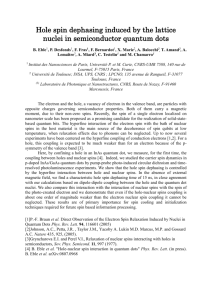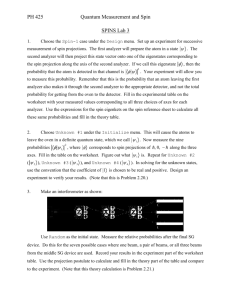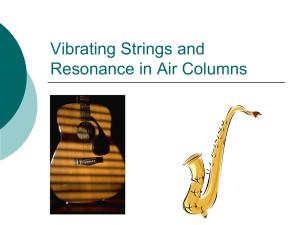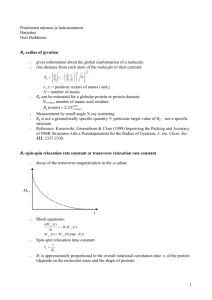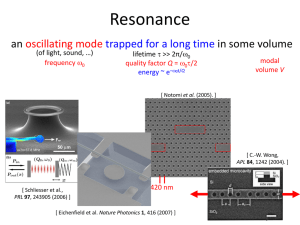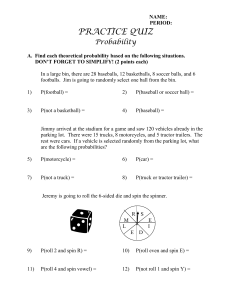Chapter 1 - New England Complex Systems Institute
advertisement
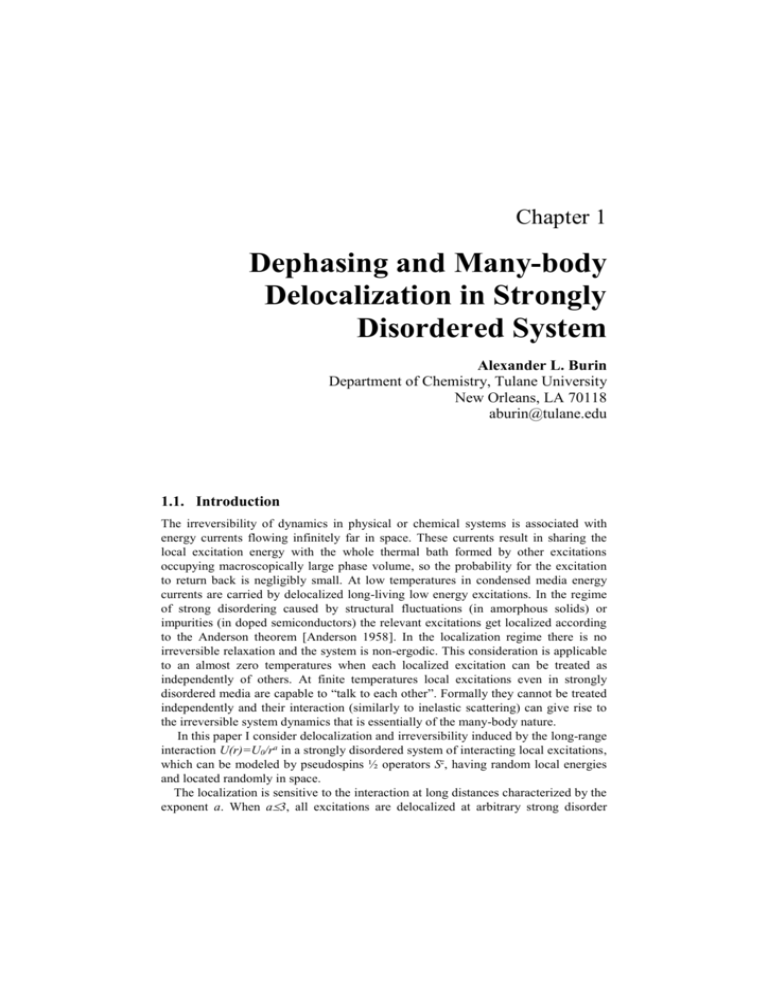
Chapter 1 Dephasing and Many-body Delocalization in Strongly Disordered System Alexander L. Burin Department of Chemistry, Tulane University New Orleans, LA 70118 aburin@tulane.edu 1.1. Introduction The irreversibility of dynamics in physical or chemical systems is associated with energy currents flowing infinitely far in space. These currents result in sharing the local excitation energy with the whole thermal bath formed by other excitations occupying macroscopically large phase volume, so the probability for the excitation to return back is negligibly small. At low temperatures in condensed media energy currents are carried by delocalized long-living low energy excitations. In the regime of strong disordering caused by structural fluctuations (in amorphous solids) or impurities (in doped semiconductors) the relevant excitations get localized according to the Anderson theorem [Anderson 1958]. In the localization regime there is no irreversible relaxation and the system is non-ergodic. This consideration is applicable to an almost zero temperatures when each localized excitation can be treated as independently of others. At finite temperatures local excitations even in strongly disordered media are capable to “talk to each other”. Formally they cannot be treated independently and their interaction (similarly to inelastic scattering) can give rise to the irreversible system dynamics that is essentially of the many-body nature. In this paper I consider delocalization and irreversibility induced by the long-range interaction U(r)=U0/ra in a strongly disordered system of interacting local excitations, which can be modeled by pseudospins ½ operators Sz, having random local energies and located randomly in space. The localization is sensitive to the interaction at long distances characterized by the exponent a. When a3, all excitations are delocalized at arbitrary strong disorder 2 Dephasing and Many-body Delocalization in Strongly Disordered System [Anderson 1958; Levitov, 1990]. This can be understood using the scaling arguments for characteristic excitation energies having with increasing the system size R. Consider the single spin in the excited state in the box of the size R. If this spin undergoes the flip-flop transition involving the second spin the change in the system energy is given by the difference in spins excitation energies. Because we do have the total number of spins N scaling as N~R3 the smallest energy of the possible flip-flop transitions scales as min~1/N~R-3. On the other hand the minimum value of a transition amplitude scales as the interaction at largest possible distance Umin~R-a. When a<3 Umin always exceeds min at sufficiently large system size R. Thus for R the flip-flop transition amplitude of any excited spin with some of other spins in its ground state always exceeds their energy difference at sufficiently large system size leading to inevitable energy sharing and the delocalization of all excitations. The finite temperature creates new objects which are the flip-flop pairs formed by the excited spin and the spin in the ground state. Because of the Pauli statistics of excitations these pairs (i, j) can be treated as the new spin entities with respect to the pair transition S iz 1 / 2, S jz 1 / 2 S iz 1 / 2, S jz 1 / 2 [Burin, Natelson, Osheroff, Kagan, 1998]. At finite temperature the number of such pairs scales as the squared number of spins Np~N2~R6, while the characteristic minimum energy difference for them is N p1 ~ R 6 . Using the interaction U min ~ R a to estimate the resonant coupling of these new entities we see that when the characteristic exponent a is less than 6 the inevitable delocalization of excitations takes place at finite temperature. This crude estimate will be confirmed by the analysis given below. This study is the extension of previous works [Burin, Natelson, Osheroff, Kagan, 1998; Burin, Kagan, Maksimov, Polishchuk, 1998; Burin, 1995] where the relaxation of tunneling defects in amorphous solids caused by their 1/R3 interaction has been investigated. The results are also applicable to other systems including electrons in doped semiconductors and interacting localized electronic and nuclear spins. The long-range interaction in these and other systems has a fundamental origin related to electrostatic or elastic forces caused by the virtual exchange of long-wavelength photons or phonons [Yu and Leggett, 1998]. The dephasing problem is very important for the performance of quantum computers [Ustinov, 2003] where pseudospins ½ of different physical nature are used as quantum bits (qubits). A long-range interaction between them can lead to the irreversible relaxation breaking the coherency needed for calculations and thus restricting the computational capability of these important devices. During the consideration below I will ignore the relaxation of excitations induced by spontaneous emission or absorption of long-wavelength phonons or photons assuming that the involved energies are so small that the rates of these processes are too slow compared to the interaction stimulated relaxation. The latter assumption is justified for amorphous solids at temperatures below 0.1K [Burin, Natelson, Osheroff, Kagan, 1998], while in other systems the restrictions can be possibly made weaker. Dephasing and Many-body Delocalization in Strongly Disordered System 3 1.2. Delocalization Mechanisms 1.2.1. Model Consider the system of interacting spins at finite low temperature T (for the sake of simplicity we set kB==1). The relevant group of spins involved into the dynamics is formed by “thermal” spins, possessing the energy i/2 in the excited state and -i/2 in the ground state with i~T. They can be described by the Hamiltonian i S iz . Let the density of such thermal spins be nT. Interaction U(r)=U0/ra representsi both the flip-flop transition amplitude leading to the energy hopping between two spins (S+S-) and the characteristic longitudinal interaction (SzSz) (see e. g. [Burin, Kagan, 1994]). 1.2.2. Resonant pairs and Anderson localization Consider the excited spin i. The problem of interest is whether it can share its excitation with one of the neighboring spins j initially located in the ground state. This requires the change in the “diagonal” part of spin energy |i-j| to be small compared to the flip-flop transition amplitude U(Rij) i j U0 . Rija (1) Two spins i and j satisfying the resonance condition (1) form a resonant pair. In this pair the excitation of the spin i is shared between spins i and j and it bounces back and forth between them back. The concept of resonant pairs can be used to study the delocalization of excitations. Each excited spin has the certain number of resonant neighbors Nr. Each of the resonant neighbors in average participates in the same number of resonances. One can consider the multi-step resonance energy transfer from the initial spin i to one of its resonance neighbors j and then from j to one of its neighbors k and so on. These coupled resonances form a percolation network. When the average number of resonance neighbors is large enough (2) N r 1, resonant spins form the infinite cluster promoting energy transport infinitely far from the initial excited spin. This leads to the irreversible spin dynamics. Let us calculate the average number of resonant neighbors Nr for the given excited spin with the energy ~T. This number is defined by the probability for the given pair of spins (i, j) to be in the resonance summed over all possible neighbors j. The probability of resonance condition (1) to be satisfied is given by the size of the resonant energy domain ( i U 0 / Rija , i U 0 / Rija ) divided by the width of the energy distribution of involved thermal spins given by the thermal energy T Pijres U 0 /(TRija ). (3) The total number of resonances can be estimated averaging the sum of probabilities (3) over possible locations of a neighboring spin j 4 Dephasing and Many-body Delocalization in Strongly Disordered System N r (U 0 nT / T ) (dR / R a )( R nT1 / 3 )( L R), (4) where the step functions (x) restrict the minimum value of the interspin distances by 1 / 3 the characteristic average distance between them nT (to avoid the irrelevant contribution of rare configurations when two spins are too close to each other) and the maximum of an interspin distance by the system size L. For a<3 the integral increases with the system size as L3-a and it diverges in the limit L. This means the inevitable delocalization for a<3 in accordance with Refs. [Anderson, 1958; Levitov, 1990]. If a=3 the divergence with the size L is logarithmic giving N r (U 0 nT / T ) ln( LnT1/ 3 ), (5) We are interested in the regime of strong disordering where the prefactor in Eq. (5) is very small 3=U0nT/T<<1. For example in amorphous solids this prefactor is as small as 10-3 e. g. [Burin and Kagan, 1994]. In this case the logarithmic factor cannot make the number Nr greater than 1 at any reasonable system size. On the other hand in the case 3 << 1 even for the large factor Nr (5) the delocalization shows up weakly [Levitov, 1990] that it cannot compete with the many-body mechanism described below at any reasonable temperature. In the case a>3 the integral in Eq. (4) is defined by the lower limit N r a U 0 nTa / 3 / T . (6) We are interested in the regime of strong disordering where a<<1 and a3. In this case the Anderson localization of all single particle excitations takes place. How to describe the system dynamics in this regime of strong disordering? The vast majority of spins in this case do not belong to the resonant pairs and they can be treated quasi-statically. The small fraction of spins a<<1 belongs to the resonant pairs (1) having the concentration anT. They are involved into quantum beats of the excitation shared between two spins. The ensemble of resonant pairs can be classified by the energy of each pair. The pair of the size R is characterized by the single energy ER~U0/Ra describing its characteristic flip-flop transition amplitude, which is close to the energy difference of involved spins Eq. (1). The inverse characteristic energy gives the period of the coherent oscillation of populations inside the pair R ~ E R1 R a / U 0 . (7) We can classify resonant pairs by their energy range starting with the maximum a/3 energy U 0 nT and reducing it each step by the scaling parameter a with some scaling factor 1. The subsystem of pairs is separated into an infinite number of energy domains enumerated by integer numbers k=0,1,2,3,4,.. and defined as (U 0 nTa / 3 / a ( k 1) , U 0 nTa / 3 / ak ). This scaling corresponds to the ranges of pair sizes knT1 / 3 k R nT1 / 3 k 1 . (8) The concentration of resonant pairs within each domain can be defined using the integral expression (4) with upper and lower limits defined by the domain boundaries (8), multiplied by the density of excited spins nT, Dephasing and Many-body Delocalization in Strongly Disordered System 5 n kp ~ nT a / k ( a 3) . (9) In the case of dipole-dipole interaction a=3 the density of resonant pairs is scale invariant because of the logarithmic behavior of the integral. We will use below the scaling (8), (9) to study the interaction of resonant pairs. The results are not sensitive to the choice of scaling parameters. 1.2.3 Delocalization induced by the interaction of resonant pairs Quantum oscillations in different resonant pairs interact with each other. This behavior contrasts to non-interacting Bose or Fermi systems where different excitations can be treated independently. The constraints for possible states of spin ½ permitting only two possible states for each spin in addition to commutation of different spin operators gives rise to finite “scattering” matrix elements for two resonant pair interaction leading to simultaneous flip-flop transitions in both pairs [Burin, Kagan 1994]. This interaction can create the collective dynamics in the ensemble of resonant pairs. Each resonant pair of spins i, j can be treated as the new spin ½ entity, characterized by the resonant doublet of two possible “flip-flop” states Szi=-Szj=1/2 and -Szi=Szj=1/2, which are strongly coupled by the interaction of spins (see Eq. (1)). Two other states, where both spins have identical values 1/2, are separated from the resonant doublet by energy gaps of order of the thermal energy. The interaction is too weak to mix the resonant doublet with two those states in the strong disordering regime a<<1 Eq. (6). The interaction of two resonant pairs falls off with the distance between them identically to the original interaction U0/Ra (cf. [Burin, Natelson, Kagan, Osheroff, 1998]). Thus we have the ensemble of resonant pairs separated into scaling domains (8), with each domain characterized by the certain pair size R, energy U0/Ra and density (9), given by n p ( R) ~ nT a (nT1 / 3 / R) a3 . How do resonant pairs of different sizes affect each other? The consideration should begin with the pairs having the 1/ 3 largest energy and the smallest possible size nT . These pairs have the largest frequency of coherent oscillations so other pairs can be treated quasi-statically with respect to them. Their interaction distance between them p can be estimated using the average minimum U min p rmin ~ (n p (nT1 / 3 )) 1 / 3 as p p U min ~ U 0 /( rmin ) a ~ U o nTa / 3 aa / 3 . a/3 T This interpair interaction is less than their energy U o n by the factor (10) a/3 a 1 in the strongly disordered system. Therefore they do not influence each other. To investigate the interaction of larger (slower) pairs we will subsequently increase the characteristic pair size by the scaling factor and repeat the above consideration for the new range of pair energies and sizes. If the interaction of pairs is much weaker than their characteristic energy then we can treat them independently as the excitations affecting only the static distribution of other spin parameters. The characteristic interaction energy V(R) within the strip of pairs with the certain size R 6 Dephasing and Many-body Delocalization in Strongly Disordered System (9) scales with this size as the characteristic interaction at the average distance between pairs belonging to that strip V ( R) ~ U 0 n p ( R) a / 3 ~ aa / 3U 0 nTa / 3 1/ 3 T (n 1 . R ) a ( a 3) / 3 (11) This interaction should be compared with the characteristics pair energy U0/Ra (cf. Eq. (7)) to examine the strength of interpair interaction. It is clear that if the interaction (11) decreases with the distance R slower than the pair energy a (a 3) / 3 a / 3, then at sufficiently large size R the flip-flop interaction of pairs exceeds their energy disordering leading to the delocalization of excitations within the ensemble of resonant pairs. Resolving the above inequality we obtain the condition for the interaction to provide the energy delocalization (12) a 6. This result is universal and does not depend on the strength of disordering. The perturbation theory analysis of the contribution of more complex resonant clusters, including for example triples and quartets, shows that it can be ignored for a>6, while for a<6 it becomes significant when the interaction of resonant pairs becomes significant (see below Eqs. (13), (14)). Therefore at a<6 we can use the resonant pairs to study the irreversible relaxation, while for a>6 the perturbation theory approach leads to the strong localization even for many-body excitations. One cannot exclude a possible asymptotic divergence of the accurate perturbation series including large clusters. This divergence should lead to exponentially slow relaxation. The crossover regime a=6 requires the special study that is beyond the scope of this paper. In the case of interest a<6 the characteristic size of pairs corresponding to the delocalization transition can be estimated setting the energy of pair interaction (11) to be approximately equal to the pair energy U0/Ra in agreement with the delocalization criterion (2). This yields R* ~ nT1 / 3 a1 /(6 a ) . (13) The interaction energy at this crossover distance defines the rate of the irreversible relaxation in the subsystem of resonant pairs 1 / * ~ U 0 R* a ~ U 0 nTa / 3 aa /(6 a ) . (14) Below we will apply this result to study dephasing and relaxation rates in the whole system of spins. 1.2.4 Dephasing and relaxation rates of spins for a<6 As was defined before the interaction of spins leads not only to the flip-flop transitions due to its flip-flop S+S- component but also to the change in energy of surrounding spins induced by irreversible transitions of resonant pairs due to the longitudinal interaction SzSz. Therefore the relaxation in the ensemble of resonant pairs gives rise to the spectral diffusion of all spin energies and, consequently, dephasing. The characteristic change E in energies of non-resonant spins during the time * of irreversible flip-flop transitions (14) is given by the interaction with the nearest resonant pair of the size R* . According to our definition of the delocalization Dephasing and Many-body Delocalization in Strongly Disordered System 7 point (14) this interaction coincides with the characteristic pair energy (14) so the energy fluctuation occurring at the time * is given by 1 / * (14). The dephasing rate can be estimated as the time when the phase fluctuation =E becomes of order of unity, see e. g. [Burin, Kagan, Maksimov, Polishchuk, 1998] (remember that we set =1). Since the energy fluctuation during the time * has the value 1 / * the phase fluctuation during this time is around one. Therefore Eq. (16) defines the dephasing rate in the system of interacting spins. The spectral diffusion changes energies of all spins including those forming resonant pairs. Therefore during the system relaxation this spectral diffusion will break some resonance pairs and form the new ones. After some time this process will include all spins with the thermal energy. In other words each spin has a very small probability to be involved into resonant pairs at the given time. After some waiting time the spectral diffusion forms its resonance with some other spin. Under resonant conditions the flip-flop transition takes place and after that the resonance pair gets broken by the spectral diffusion. The spin waits the vast majority of time to be involved into the new resonance. This waiting time 1 defines the longitudinal relaxation rate of spins. It is given by the quasi-period of the spectral diffusion. How to find the spectral diffusion period? The process under consideration is of the self-consistent nature so the spin transitions induces the spectral diffusion, which itself induces the spin transitions. In this regime the possibility of a long term memory effects in the spectral diffusion can be significant. Let us ignore such a memory and then verify this assumption self-consistently. During the time * resonant pairs of the size the spins with the density n* n p ( R* ) , belonging to R* , make their transitions. These transitions lead to the spin 1 / * removing spins of the resonant subsystem out of the resonance and creating n* of new resonant spins. The multiple repetition of this energy fluctuation process leads to growing the density of spins making transitions within the time range (0, t) as n(t ) n*t / * . At the time t equal to the longitudinal relaxation time 1 this concentration approaches the total spin concentration nT and all spins make in average one transition. Then the longitudinal relaxation rate can be estimated as 1 / 1 1 / * (n* / nT ) ~ U 0 nTa / 3 a(3 a ) /(6a ) . (15) The absence of the significant memory in the spectral diffusion can be justified considering time dependent energy fluctuations. The energy fluctuation induced by transitions of all spins in the subsystem of concentration n can be estimated as the characteristic interaction with the closest spin from this subsystem, given by Una/3. This fluctuation increases with the time t as E (t ) ~ (1 / * )(t / * ) . Thus we are dealing with the super-diffusion having the probability to return back defined by the a/3 integral dt / t a/3 converging in the long time limit for a>3. This makes the probability of correlated transitions within the same resonant pair negligible. The special case a=3 requires the separate study. The analysis, made in Ref. [Burin, 8 Dephasing and Many-body Delocalization in Strongly Disordered System Kagan, 1994] shows that for two level defects in amorphous solids the memory effects can also be approximately neglected. 1.3. Conclusion It was shown that the long-range interaction U(R)~R-a with a<6 always leads to the irreversible relaxation and dephasing in strongly disordered systems at any finite temperature. Relaxation and dephasing rates are computed. Applications of the above consideration to 1/R3 interacting tunneling systems in amorphous solids have leaded to a certain progress in understanding low temperature relaxation experiments see e.g. [Enss, 2002; Burin, Natelson, Osheroff, Kagan, 1998]. The results can be applied to other problems including interacting qubits in quantum computers. Dephasing can crucially affect the coherent evolution of qubits in a quantum computation process. One possible way to reduce the interaction stimulated dephasing is to use low dimensional systems, where 1/R3 interaction will be much less efficient. In fact, this effect has been recently demonstrated in acoustic measurements in glasses [Ladieu, Le Cochec, Pari, Trouslard, Ailloud, 2003]. This work is partially supported by TAMS GL fund (account no. 211043) through the Tulane University. Author is grateful to his advisors and colleagues Yuri Kagan, Leonid Maksimov, Il’ya Polishchuk, Douglas Osheroff and Clare Yu for many useful ideas, discussions and suggestions kindly provided by them. References Anderson, P. W., 1958, Absence of diffusion in certain random lattices, Physical Reviews, 1492, 109. Burin, A. L., Natelson, D., Osheroff, D. D., Kagan, Yu, 1998, Interaction between Tunneling Defects, in Tunneling Systems in Amorphous and Crystallline Solids, edited by P. Esquinazi, Springer-Verlag (Berlin, Heidelberg, New York), 223. Levitov, L., S., 1990, Delocalization of vibrational modes caused by electric dipole interaction, Physical Review Letters, 547, 64. Ladieu, F., Le Cochec, J., Pari, P., Trouslard, P., Ailloud, P., 2003, Physical Review Letters, 205501, 90. Burin, A. L., Kagan, Yu., 1994, Low Energy Collective Excitations in Glasses. New Relaxation Mechanism at Ultralow Temperatures, Journal of Experimental and theoretical Physics, 633, 106. Burin, A. L., Kagan, Yu., Maksimov, L.A., Polishchuk, I. Y., 1998, Dephasing rate in dielectric glasses at ultralow temperatures, Physical Review Letters, 2945, 80. Burin, A. L., 1995, Dipole gap effects in low energy excitations spectrum of amorphous solids – theory for dielectric relaxation, Journal of Low Temperature Physics, 309, 100. Enss C. C., 2002, Beyond the tunneling model: quantum phenomena in ultracold glasses, Physica B, 12, 316. Yu, C. C., Leggett, A. J., 1998, Low-temperature properties of amorphous materials: through a glass darkly, Comments on Condensed Matter Physics 231, 14. Ustinov, A., 2003, Quantum Computing Using Superconductors, in Nanoelectronics and Information Technology, Advanced Electronic Materials and Novel Device, edited by R. Waiser, Wiley-VCH (Berlin), 463.

